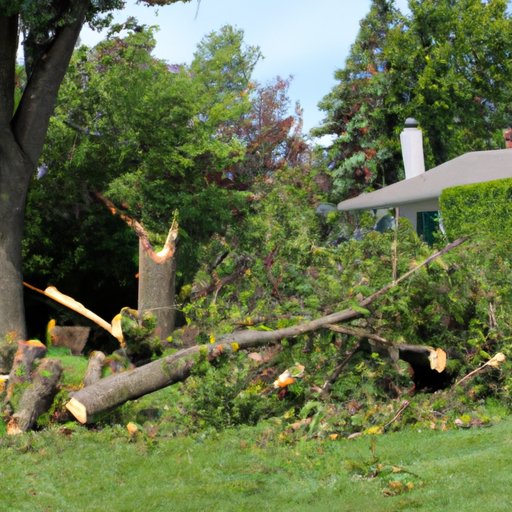Introduction
Tree removal can be a daunting task for homeowners, but it is sometimes necessary in order to protect the safety of your property and those living in it. But how much does it cost to cut down a tree? This article provides a comprehensive guide to calculating the cost of tree removal, exploring what factors impact the price, the benefits and drawbacks of DIY tree cutting versus hiring a professional, and an overview of average tree removal costs across the United States.

A Comprehensive Guide to Calculating the Cost of Tree Removal
When trying to calculate the cost of tree removal, there are several factors to consider. Some common questions to ask include: What is the size and location of the tree? What type of tree is it? Is it accessible? These factors, as well as others, will all impact the price of tree removal.
What Factors Impact the Price of Tree Removal?
The size and location of the tree will have a major impact on the cost of tree removal. Trees that are large, tall, close to buildings or power lines, or in difficult-to-access areas will require more time and effort to remove and will therefore cost more. Additionally, the type of tree will also affect the price. Hardwood trees, such as oak and maple, are much more difficult to remove than softwood trees like pine and fir, so they will cost more.
Other factors that can influence the price of tree removal include the number of trees being removed, the amount of debris to be disposed of, and any special equipment that may need to be used. In some cases, additional fees may be charged for stump grinding, hauling away the debris, or even replanting a new tree.

The Pros and Cons of DIY Tree Cutting vs. Hiring a Professional
Many people choose to take on the task of cutting down a tree themselves. There are some benefits to this approach, including saving money and having complete control over the process. However, there are also several drawbacks to DIY tree cutting, including safety risks, lack of experience and knowledge, and difficulty accessing hard-to-reach areas. For these reasons, it is usually best to hire a professional tree removal service.
Hiring a professional tree removal service has its own set of advantages and disadvantages. On the plus side, professionals have the experience, knowledge, and proper tools and equipment to safely and efficiently remove trees. They also have access to specialized techniques, such as crane removal, that may be necessary in certain circumstances. The downside to hiring a professional is that it can be expensive, and there is no guarantee that the job will be done correctly.

How to Spot a Fair Price for Tree Removal Services
When looking for a tree removal service, it is important to do your research. Get estimates from multiple companies and compare prices. Be sure to ask for references and read online reviews to ensure that the company you choose is reputable and reliable. It is also a good idea to get a written estimate before the job begins so that you know exactly what you will be paying for.
An Overview of Average Tree Removal Costs Across the U.S.
The national average cost of tree removal is around $890. However, regional differences can cause prices to vary significantly. In some parts of the country, such as the Northeast, tree removal services can be quite expensive, while in other areas, such as the Midwest, the cost may be lower. Additionally, the size and type of tree, as well as any additional services required, will all factor into the final cost.
Conclusion
Cutting down a tree can be a costly endeavor. The price of tree removal varies depending on several factors, including size and location, type of tree, accessibility, and additional services required. Homeowners must weigh the pros and cons of DIY tree cutting versus hiring a professional, and research companies and get estimates to find a fair price for tree removal services. The national average cost of tree removal is around $890, although regional differences can cause this price to fluctuate.


